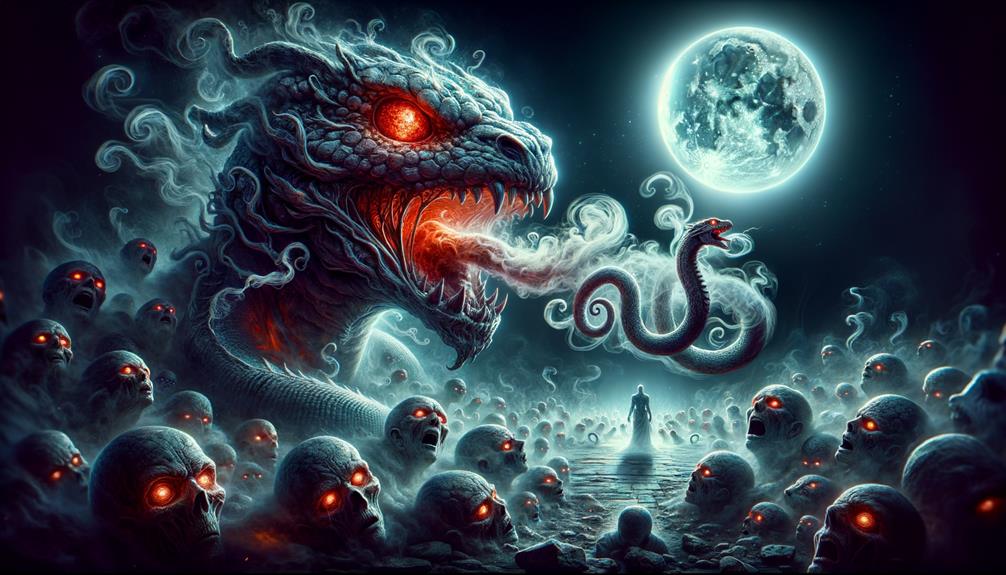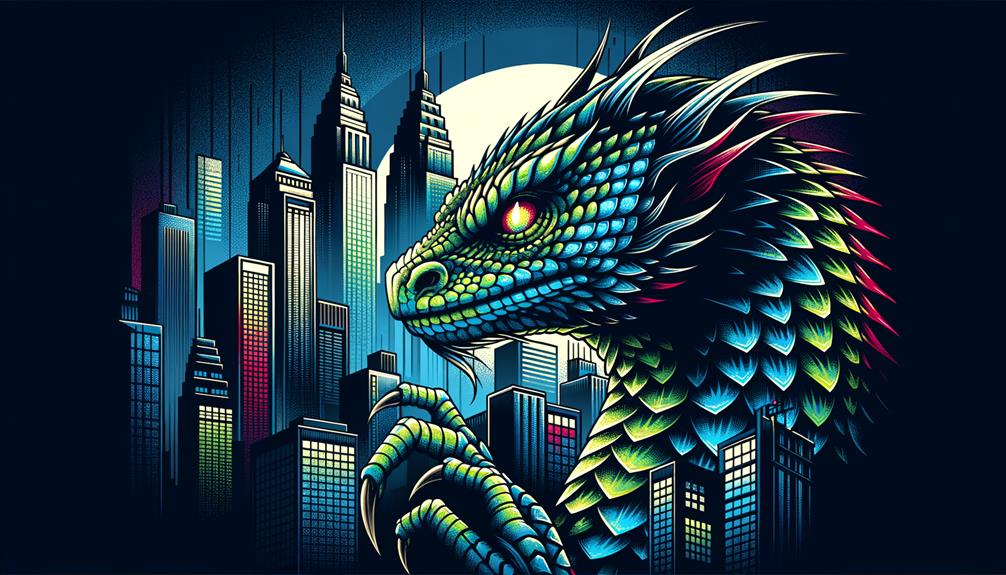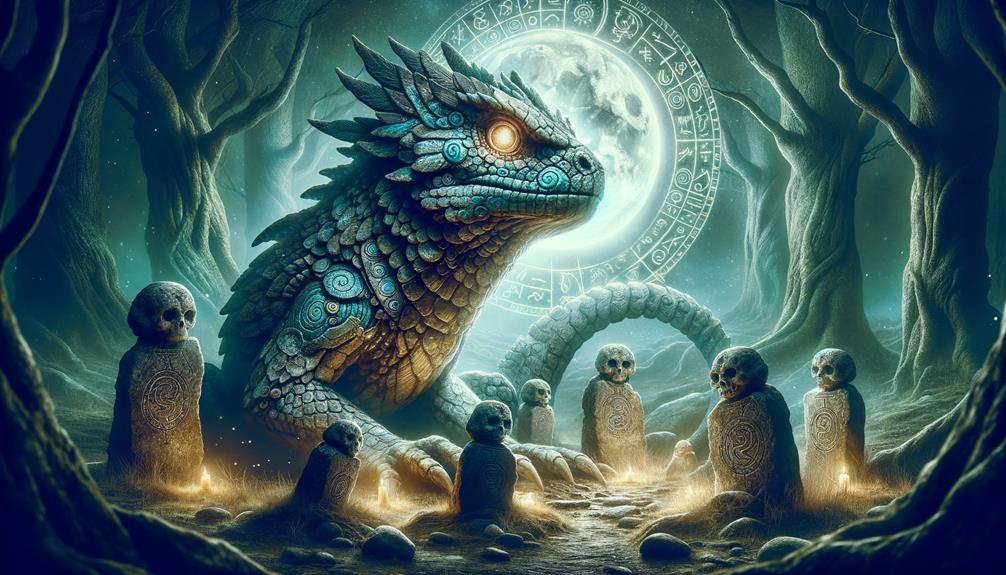Unraveling the rich lore of the basilisk, a mythical creature known for its lethal reputation, can be a thrilling journey. Known for striking fear in the hearts of many, this beast is one of the most deadly creatures in mythology. Just one look into its eyes is believed to be fatal.
In this exciting exploration, we're going to dive into the fascinating world of the basilisk. We'll break down its name origin, bring its chilling attributes to light, and track its presence in folklore and cultural narratives throughout the ages.
We'll dig into historical records and tall tales, revealing the meanings and symbols tied to this fearsome beast across various cultures. But be warned, as we navigate this maze of history and myth, the allure of the basilisk may draw us in, leaving us yearning for more knowledge about its captivating mythology.
Origins of the Basilisk Myth

The term 'basilisk' comes from Greek and refers to a specific type of snake, but the mythical beast we know today is the result of many different stories from various cultures. This legendary creature is often depicted as a dangerous beast with a lethal stare that can turn people to stone. Its usual description is that of a strange hybrid, part rooster, part snake, and it has intrigued people for hundreds of years.
The first person to write about the basilisk was Pliny the Elder in his 34th book of Natural History, and his accounts played a big role in shaping its mythology. As time passed, the creature's image changed, influenced by other stories and observations from nature. Alexander Neckam, a 12th-century English scholar, added to the legend of the basilisk by linking it with symbols of evil or Satan.
The lethal nature of the basilisk and its ability to kill with a glance have been used as potent symbols in stories and legends, representing the destructive power of uncontrolled aspiration or ill will. Its mixed form, usually described as a rooster with snake-like features, emphasizes its strange and frightening nature. Therefore, the stories about the basilisk provide an interesting look at how different cultures view and represent evil.
Basilisk Depictions in Literature

Dipping into the world of literature, we encounter the startling symbolism and fear-evoking aspects of the basilisk, used by a wide range of authors including Chaucer, Shakespeare, Stoker, and Rowling. The basilisk is often painted as a rooster sporting a serpent's tail, a mix of mismatched elements that form a creature that is both imposing and fear-inducing.
It's widely agreed that the basilisk holds the power of causing death simply by looking at its victim. This fatal stare is a recurring theme, demonstrating the deadly potential of this mythical beast. In some tales, the poison of the basilisk is likened to the venom of an Egyptian cobra, which further magnifies its lethal reputation.
Chaucer, in his 'The Nun's Priest's Tale,' portrays the basilisk as a creature whose stare is fatal. Shakespeare uses the basilisk as a metaphor for a deadly gaze in 'Richard III.' Stoker's 'The Lair of the White Worm' paints the basilisk as a horrific worm. However, Rowling, in 'Harry Potter,' while keeping the traditional deadly stare, presents the basilisk as a massive snake, perfectly capturing the terror and wonder this mythical creature instills throughout literature.
The Basilisk's Fearful Powers

When we talk about the terrifying powers of the basilisk, it's key to acknowledge its origins in multiple mythologies. It's often associated with symbols of evil or the devil, and has evolved into a significant symbol in the field of alchemy. This beast, usually illustrated with eight chicken feet, is a representation of destruction and chaos, symbolizing wickedness throughout history.
The birth of a basilisk is believed to occur from an egg warmed by a toad. The basilisk holds a deadly gaze that can obliterate plants and stones just by its toxic presence. As a protector, it's both respected and dreaded. So much so, an image of this creature has become the emblem of the Swiss city of Basel, demonstrating its long-lasting impact.
The terrifying powers of the basilisk go beyond the physical, holding a symbolic power that resonates in our shared awareness. Its snake-like form, often compared to a sea snake, reinforces its connection with the mysterious deep and the unknown, projecting an ominous yet intriguing shadow that has lasted for hundreds of years.
In this discussion about basilisk tales, it's important to grasp the mythological importance of the creature and the powers it symbolizes, both real and metaphorical. To fully comprehend the basilisk, we need to dive deep into the world of myth and symbol, confronting our darkest fears and curiosities.
Basilisk Symbolism Across Cultures

Let's delve into the fascinating realm of the basilisk's symbolic meanings across various cultures. This creature, often associated with evil and death, is a staple in many traditional stories, embodying a multitude of destructive forces.
In the world of alchemy, the basilisk is seen as the vessel for the 'philosopher's stone', which signifies a deep and profound transformation. This concept has its roots in the work of Hermes Trismegistus, a legendary figure of Hellenistic wisdom.
Some tales speak of a 'white spot' on the basilisk's head, interpreting it as a container for the above-mentioned stone.
In Christian symbolism, the basilisk is often viewed as a representation of the devil or sin, and is even referred to as the 'husbands murderer' due to its lethal gaze.
An intriguing aspect is the use of the scent of a weasel, the only known predator of the basilisk, in certain cultures to fend off evil spirits. This could hint at an awareness of the basilisk's Achilles heel.
Modern Interpretations of Basilisks

In the world of storytelling today, basilisks are often painted as horrifying snakes boasting deadly powers, embodying destruction and disorder. The venom they carry is alarmingly potent, causing massive wreckage wherever they go. Interestingly, their portrayal has transformed from a tiny beast, about the length of twelve fingers, to a gigantic snake.
In Lucerne, a city in Switzerland, you'll find a basilisk cast in stone, complete with a rooster's crown, demonstrating its legendary blend of bird and reptile features. This representation mirrors the creature's historic image as a rooster-snake mix, multiplying its threatening aura.
In popular books of our times, like J.K. Rowling's Harry Potter series, the basilisk's lethal stare is highlighted to intensify its destructive powers. This portrayal drives home the idea that the creature symbolizes chaos and wickedness.
Frequently Asked Questions
What Is the Myth of the Basilisk?
So, you're curious about the basilisk myth, huh? Well, it's a hair-raising tale about a horrifying beast. This monster, they say, is born from an egg laid by a serpent and hatched by a rooster. Imagine that! And if that's not scary enough, legend has it that the basilisk can end lives with just one look or a single breath. It's an intriguing peek into the fears and superstitions that our ancestors held dear.
Where Did the Story of the Basilisk Come From?
So, you're wondering about the origins of the basilisk story? Well, let's dive into it! This fascinating creature comes from the world of Greek mythology. Over the years, it has been depicted as a terrifying hybrid in the works of renowned authors like Chaucer, Shakespeare, Stoker, and Rowling. The basilisk is usually represented as a symbol of destruction, chaos, and the embodiment of pure evil. It's a really intriguing part of literary history, don't you think?
What Does a Basilisk Symbolize?
When we delve into the heart of mythology, we find that the basilisk is often painted as a symbol of malevolence and mortality. Its fatal eyes, poisonous fangs, and lethal breath position it as a powerful symbol of dread, horror, and the more ominous elements of mythological stories.
How Big Is a Basilisk Mythology?
When it comes to the size of a basilisk in mythology, there's no set standard. That being said, it's often shown as a remarkably large creature, a reflection of its incredible power and dark nature. So, in the colourful world of folklore, the basilisk is generally seen as a creature of great scale.

